
95% of researchers rate our articles as excellent or good
Learn more about the work of our research integrity team to safeguard the quality of each article we publish.
Find out more
ORIGINAL RESEARCH article
Front. Astron. Space Sci. , 26 March 2025
Sec. Space Physics
Volume 12 - 2025 | https://doi.org/10.3389/fspas.2025.1533126
This article is part of the Research Topic Dynamic Exospheres of Terrestrial Bodies Through The Solar System View all 8 articles
 Gonzalo Cucho-Padin1,2*
Gonzalo Cucho-Padin1,2* Cristian P. Ferradas2,3
Cristian P. Ferradas2,3 Mei-Ching Fok3
Mei-Ching Fok3 Lara Waldrop4
Lara Waldrop4 Jochen Zoennchen5
Jochen Zoennchen5 Suk-Bin Kang2,3
Suk-Bin Kang2,3The charge exchange interaction between exospheric hydrogen (H) atoms and energetic ions in the terrestrial ring current is a crucial mechanism for dissipating global magnetospheric energy, especially during the recovery phase of geomagnetic storms. Historically, ring current modeling has considered H density distributions temporally static and spherically symmetric owing to the lack of event-specific exospheric models. However, observations of the far-ultraviolet (FUV) emission from exospheric H atoms acquired by NASA’s TWINS Lyman-Alpha Detectors (LADs) unveiled not only spatial asymmetries but also significant temporal variability of this neutral population, particularly during storm time. In this work, we investigate the influence of realistic exospheric H density distributions on the ring current decay during the strong storm on 1 June 2013. To do so, we first estimate time-dependent, three-dimensional (3-D) H density distributions using FUV radiance data acquired by TWINS/LADs with a robust tomographic approach. Then, we use these neutral distributions as inputs for the Comprehensive Inner Magnetosphere-Ionosphere (CIMI) model and simulate the ion ring current behavior as a response to the exospheric dynamics. We compared the resulting ion fluxes with those produced when a static and spherically symmetric H model (Rairden's model) is used. We found that the TWINS-based global hydrogen density beyond 3
The outermost region of the Earth’s atmosphere is known as the exosphere and extends beyond several hundreds of kilometers (
Previous studies demonstrated the crucial role of the exosphere in inner magnetospheric dynamics due to charge exchange interactions. Early in the space exploration era, observational and theoretical studies of the near-Earth plasma environment linked the strength of geomagnetic storms to the development of the terrestrial ring current, and its recovery to quiet-time conditions was associated with the transfer of energy from ring current ions to exospheric H atoms via charge exchange (Dessler and Parker, 1959). Since then, numerous studies have stated the critical role of the spatial density distribution of the neutral population in ring current dynamics, especially in the decay phase [(Jordanova, 2020); and references therein]. Because the exospheric H density decreases with increasing radial distance, the effects of charge exchange are larger, and its role in defining the ring current distribution is more important at low L shells. Moreover, since the ring current is composed of a variety of ion species, each having distinct charge exchange timescales (i.e., cross sections), their interactions with exospheric atoms highly affect not only the overall ring current decay evolution but also its ion composition and redistribution. This particular effect was shown by measurements that reported heavy ions dominating over the overall most abundant protons at the low L shells near the inner edge of the ring current (Ferradas et al., 2015; Ferradas et al., 2016; Kistler et al., 1989; Kistler et al., 1998; Lundin et al., 1980). This was well explained by the significantly longer charge exchange lifetimes of heavy ions compared to those of protons at those energies.
With more emphasis on the variability of the geocoronal population, Krall et al. (2018) conducted a study to evaluate the impact of atomic H on the temporal rates of plasmaspheric refilling and ring current recovery after a geomagnetic storm. They pointed out the prevailing uncertainty of the current knowledge of exospheric densities and tested plasmasphere and ring current models using H concentrations derived from the NRLMSIS (Emmert et al., 2021; Rairden et al., 1986) H models, which included multiplicative factors of 0.5 and 2 supported by preceding data-based comparison studies (Waldrop and Paxton, 2013; Nossal et al., 2012; Kotov et al., 2023). The results showed that a fast ring current recovery rate is highly associated with large exospheric H densities.
A specific investigation on the impact of geocoronal densities on ring current dynamics has been previously conducted by Ilie et al. (2013). For this purpose, they used a kinetic model known as the Hot Electron Ion Drift Integrator (HEIDI) to simulate ion dynamics in the ring current, as well as several state-of-the-art models of the terrestrial exosphere, which are briefly described here since it is pertinent to our study. 1) Hodges (1994) implemented a Monte-Carlo simulation of the exosphere that simulates atomic H dynamics from its origin in the middle thermosphere and its path towards the exosphere following ballistic, escaping, and satellite trajectories. The model considers ion-neutral interactions with various plasma populations, e.g., topside ionosphere, plasmasphere, and polar wind. 2) Rairden et al. (1986) estimated a spherically symmetric model of the exosphere based on an isothermal distribution of H atoms (Chamberlain, 1963) and measurements of the scattered Lyman-alpha (Ly-
Recently, Zoennchen et al. (2024) determined the 3-D structure of exospheric H density distributions using multi-day observations of TWINS/LADs instruments for both solar minimum and maximum conditions. It was found that the exosphere during solar maximum is
To quantify the effect of a realistic exospheric H density in ring current dynamics, this research work presents a comparative study between simulations of the ring current ion distributions during a geomagnetic storm using two exospheric models: a data-based model derived from actual TWINS emission data and the spherically symmetric and temporally static Rairden et al. (1986) model. In addition, these ion flux results are compared with in situ measurements acquired by the Van Allen Probes mission. This manuscript is organized as follows. Section 2 describes the event selected for this study, the remote sensing techniques to estimate H density from FUV emissions, and the model to simulate ring current ion dynamics. Section 3 presents the two ring current simulation results and the comparison between ion fluxes and total ring current energy during the evolution of the storm. Also, this section shows the comparison of these results with in situ observations from Van-Allen Probes. Finally, Section ?? discusses the results of our study and lists our conclusions.
This study analyzes the intense geomagnetic storm that was triggered by the arrival of a coronal mass ejection (CME) and began with a sudden commencement on 1 June 2013, around 0300 UT, with a main phase that lasted for about 6 h until
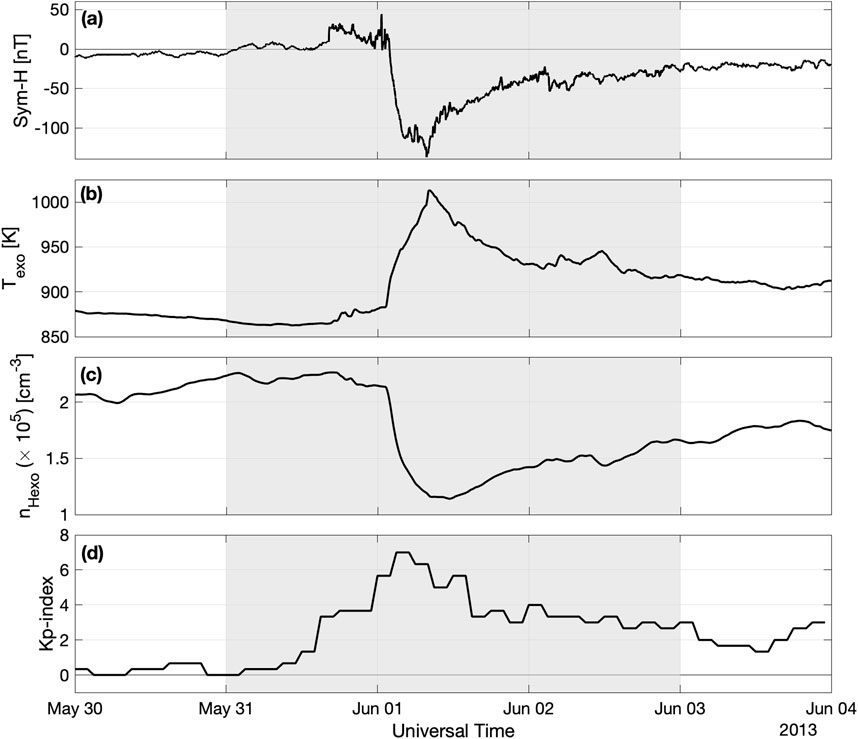
Figure 1. Overview of the intense geomagnetic storm on 1 June 2013. Panels from top to bottom indicate (a) SYM-H, (b) globally-averaged exobase temperature
The variability of exospheric densities at ring current altitudes during a geomagnetic storm is typically associated with the global distribution and temporal variability of the temperature and densities at the exobase (
We estimate global exospheric densities using radiance data from the TWINS mission. NASA’s TWINS is comprised of two spacecraft, TWINS1 and TWINS2, each of them featuring a highly elliptical orbit, an apogee in the Northern ecliptic hemisphere of 7.2
To analyze the storm that occurred on 1 June 2013, we use radiance data acquired by LAD1/2 onboard the TWINS1 spacecraft for 3 days from May 31 to June 2. The LADs onboard TWINS2 were out of commission after 2012.
In this study, we estimate time-dependent, global H density distributions from Ly-
where
Radiance data from LAD1/2 onboard TWINS1 are used to generate a dataset that should be pre-processed and filtered according to the following constraints:
• Re-emission from the lower exosphere known as Earth’s Albedo is a secondary source of Ly-
• LAD’s LOSs passing through a cylinder of radius 3.75
• LAD’s LOSs with positive
We use a tomographic approach to convert 1-D radiance measurements from LADs into 3-D hydrogen density distributions beyond 3
The time-dependent reconstruction of the exosphere requires solving the dynamic system
where
Tomographic reconstructions of exospheric density distribution are conducted “hourly” (i.e., the cadence of
Since ring current modeling needs H densities below 3.75
The first column of Figure 2 shows the time-dependent, global tomographic reconstruction of the exospheric
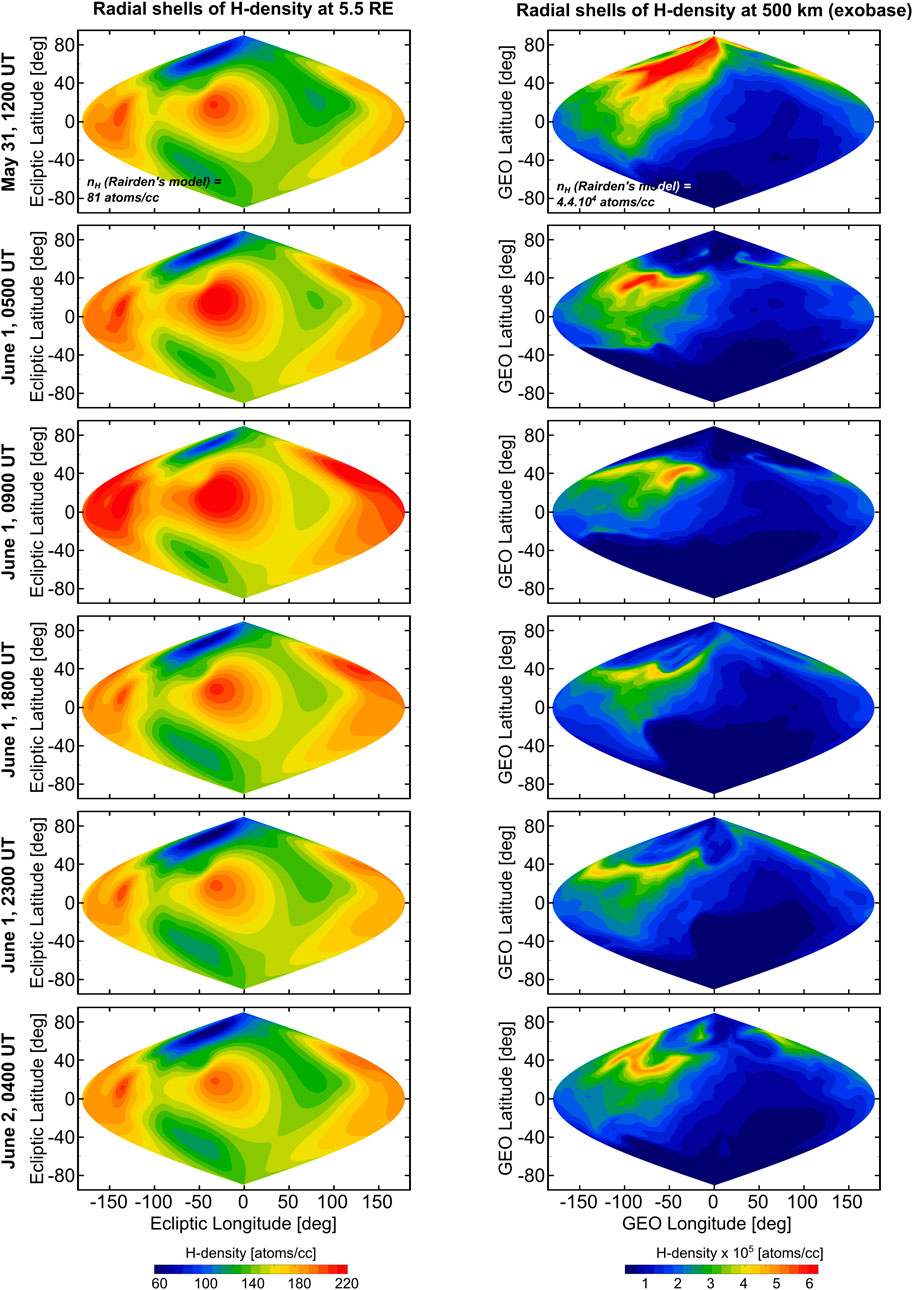
Figure 2. Temporal evolution of the exospheric H densities during the development of the storm. The first column displays radial shells of H-density at 5.5
During the geomagnetic storm, there was an evident global enhancement of H densities beyond 3
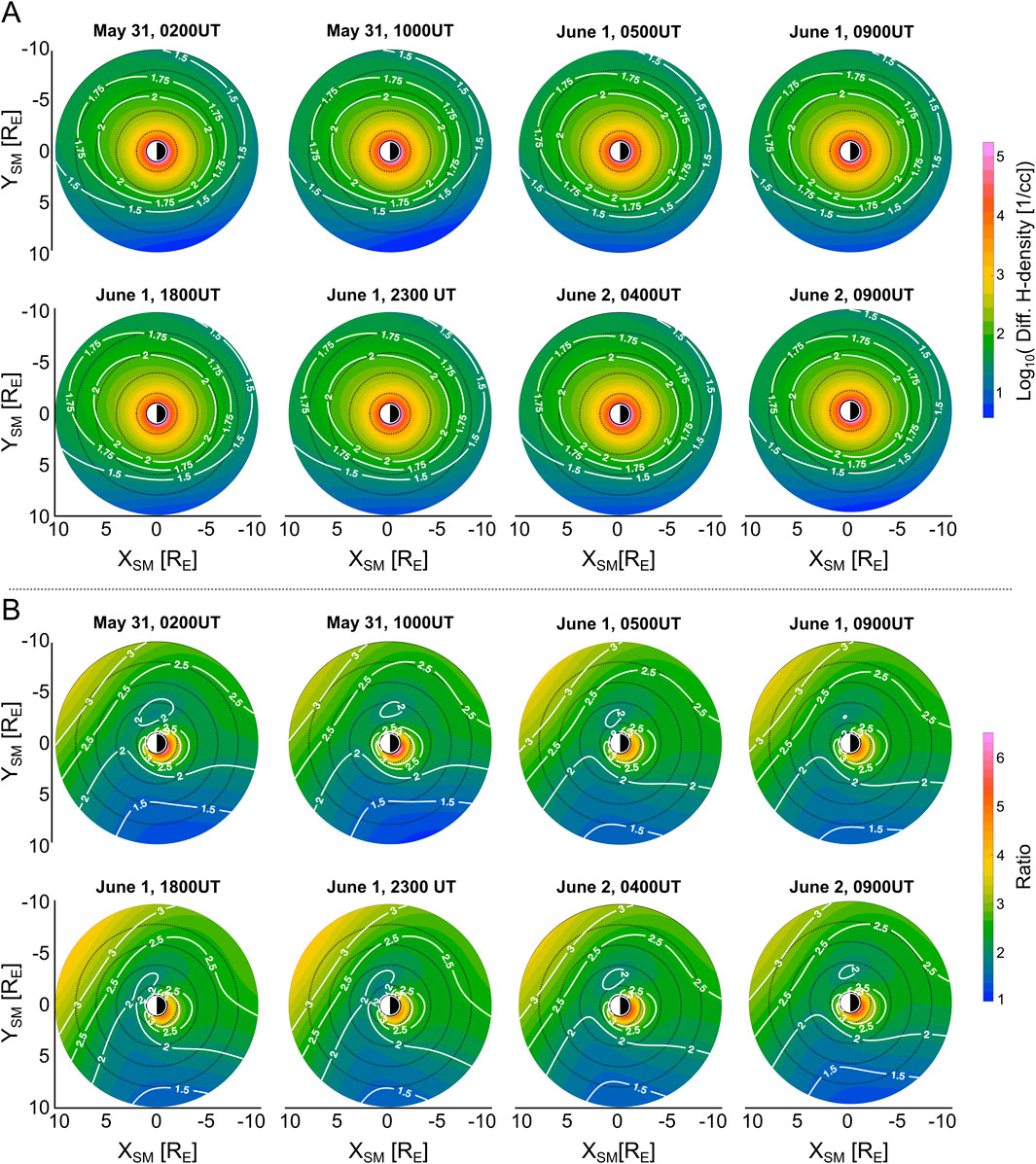
Figure 3. Quantitative comparison between exospheric models used in this study. (A) shows the difference in H densities between DynH and StH models expressed in
Through the analysis of these plots, we found that the DynH model exhibits larger H densities than the StH model for all periods and at all altitudes (500 km–10
To determine the ring current development during the 1 June 2013 storm, we use the Comprehensive Inner Magnetosphere-Ionosphere (CIMI) model designed and implemented by Fok et al. (2014), Fok et al. (2021), which simulates the ring current ion fluxes and the magnetospheric electric field. CIMI is a kinetic model that calculates ion (0.1–500 keV) and electron (1 keV–6 MeV) distributions, the subauroral Region-2 field-aligned currents, the sub-auroral ionospheric potentials, and the plasmasphere distributions by solving (a) the bounce-averaged Boltzmann equation for the distribution functions of energetic ions and electrons, (b) the conservation equation of plasmasphere particles, and (c) the ionospheric current conservation equation for the ionospheric potential. The spatial domain of CIMI is circumscribed to the closed magnetic field region bounded by the dayside magnetopause located at a typical radial geocentric distance of 10
To assess the role of a realistic terrestrial exosphere in the ring current decay, we use the CIMI model to simulate the ring current ion fluxes and their dynamic response to two distinct exospheric models (StH and DynH) during 3 days from May 31 to 2 June 2013. Then, the CIMI model is configured to calculate the fluxes of
To examine the ring current development and its response to a given exospheric density model, we analyze the resulting ion fluxes for both “runs”. Figure 4 shows the ion flux comparison between CIMI simulations coupled with the static and dynamic H exospheric models during quiet time conditions, i.e., 31 May 0200 UT, and 1000 UT. For each species, the figure shows ion flux estimates using CIMI coupled with the StH and DynH models. To quantify the differences between runs, we calculated the log accuracy ratio,
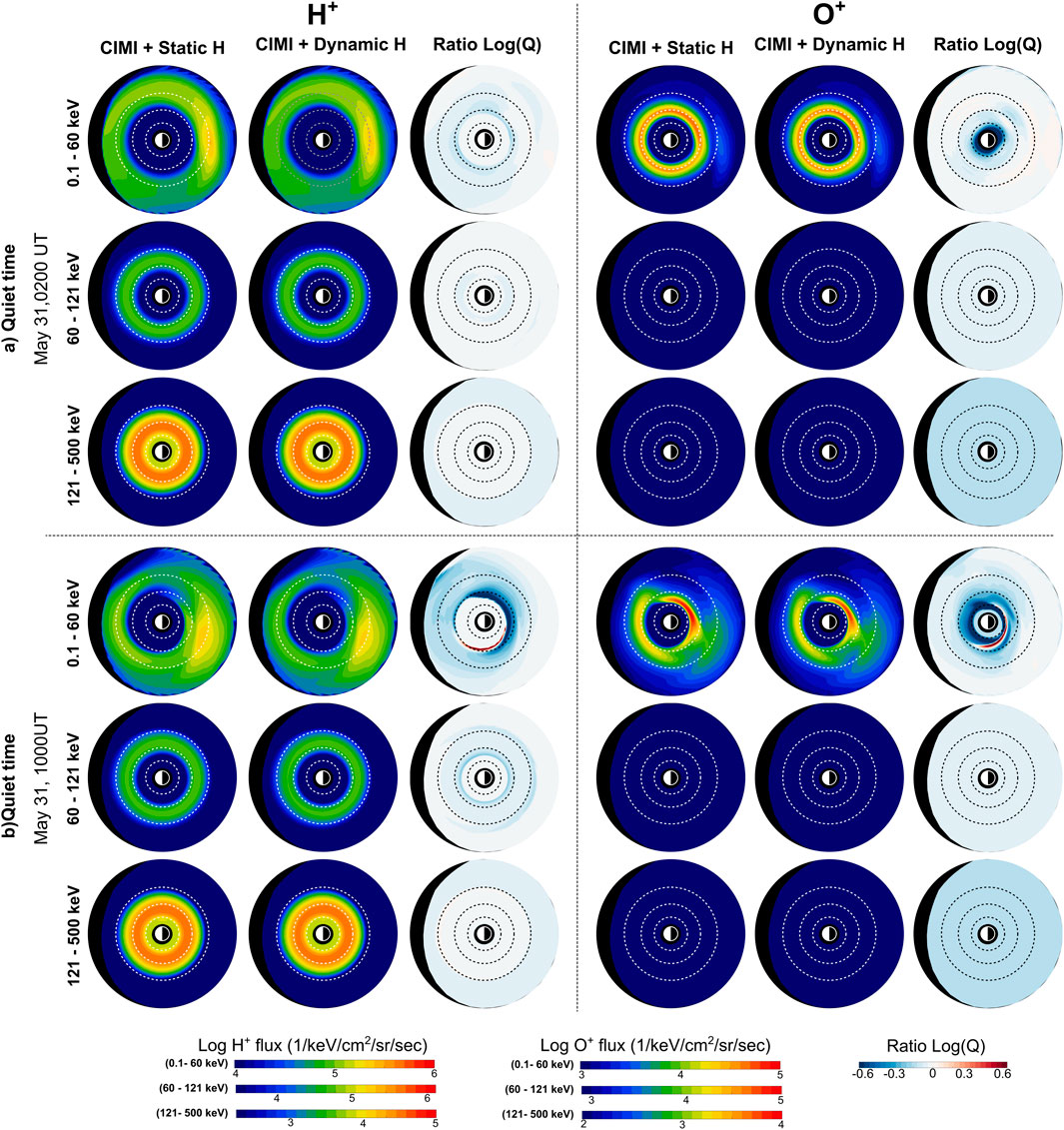
Figure 4. Comparison between ion fluxes generated by CIMI simulations using static and dynamic exospheric models for 31 May 0200 UT and 1000 UT. Each panel (out of 4) contains 9 graphs of equatorial ion flux distributions arranged as follows: the first and second columns depict ion flux results of using CIMI coupled with the static and dynamic H, respectively, and the third column shows the ion flux ratio defined as Log

Figure 5. Comparison between ion fluxes generated by CIMI simulations using static and dynamic exospheric H models for 1 June 0500 UT and 1 June 0900 UT. This figure uses an identical format to Figure 4. (a) Main phase, (b) Storm peak.
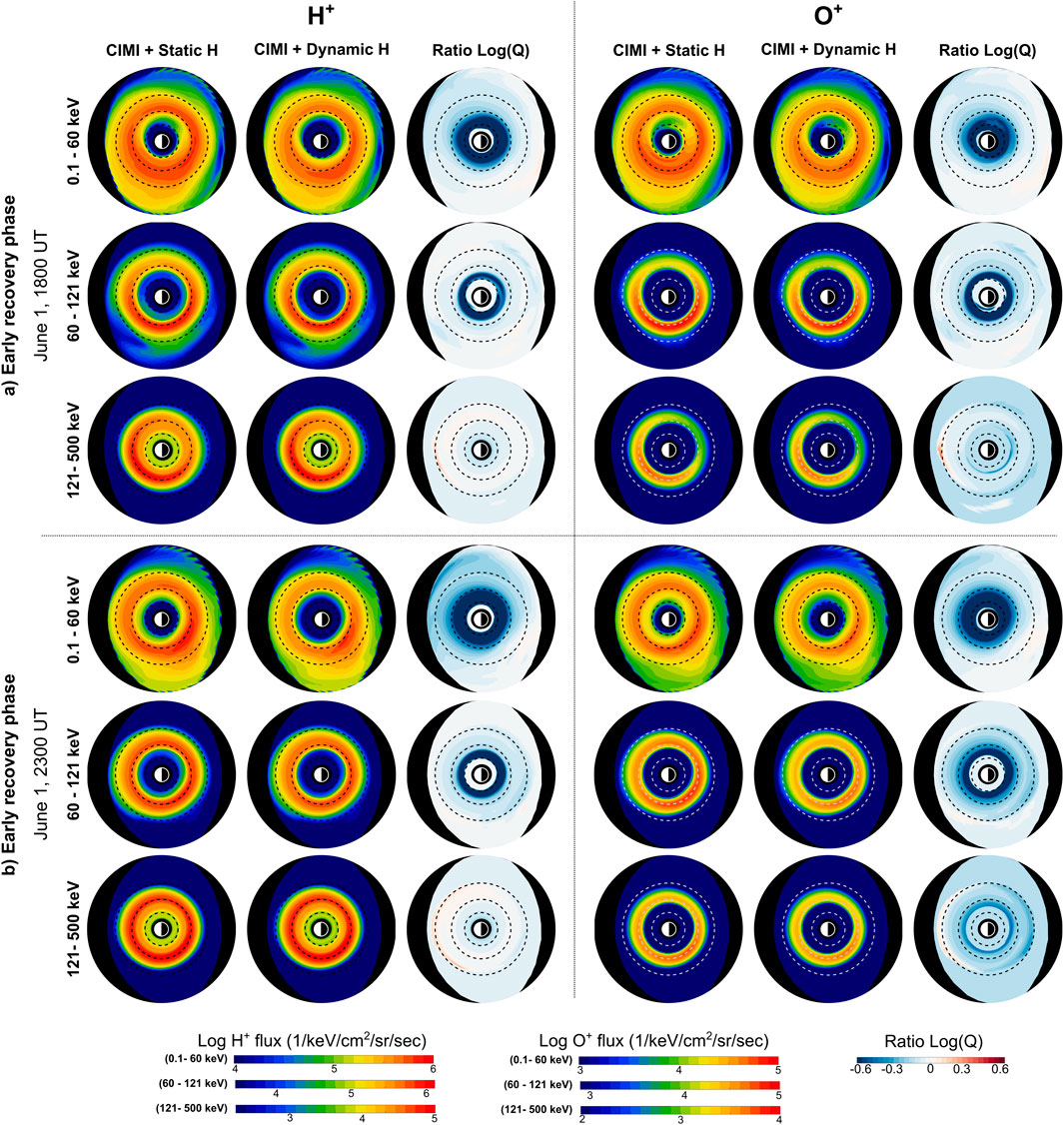
Figure 6. Comparison between ion fluxes generated by CIMI simulations using static and dynamic exospheric H models for 1 June 1800 UT and 1 June 2300 UT. This figure uses an identical format to Figure 4. (a) Early recovery phase (b) Early recovery phase.
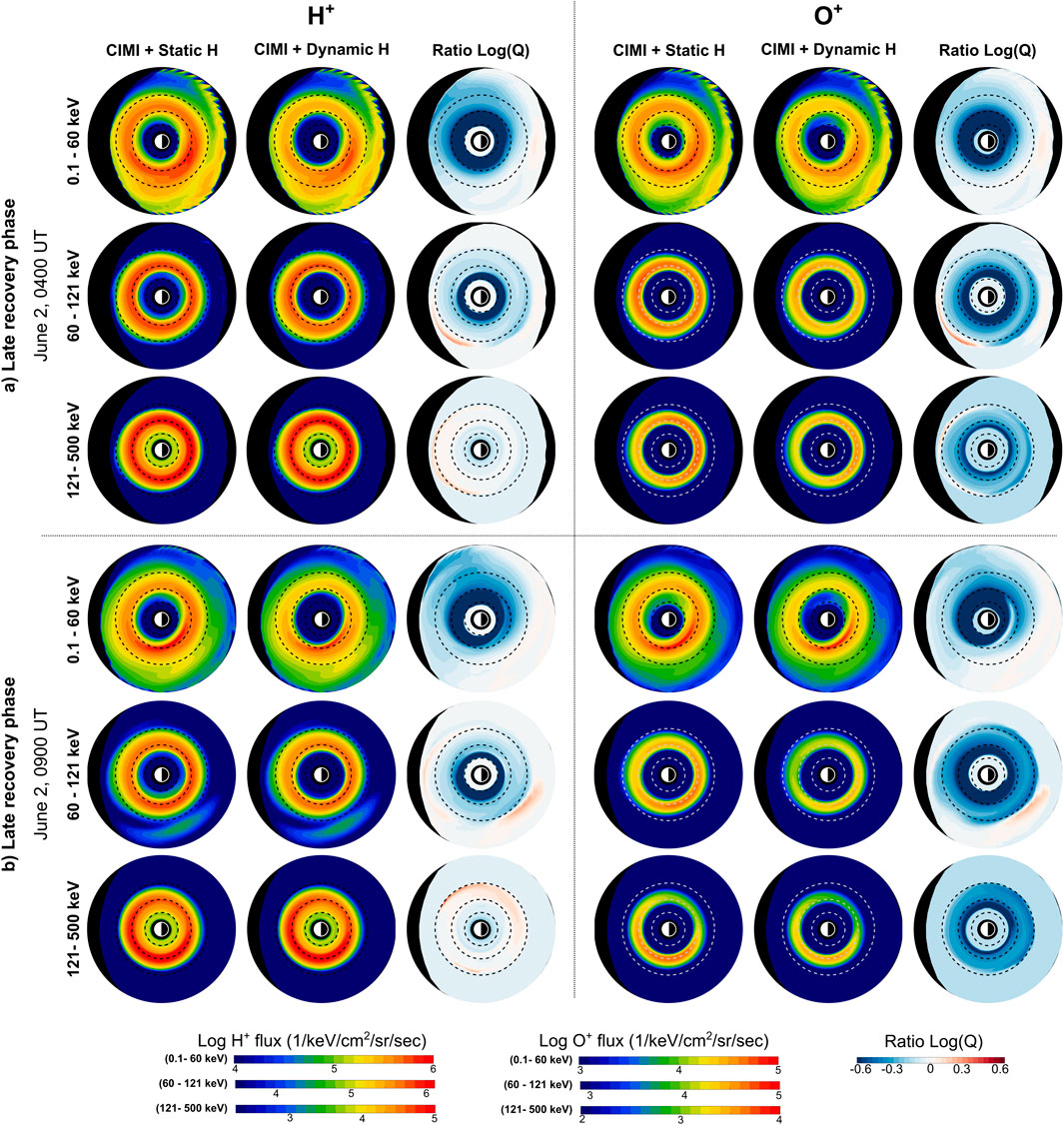
Figure 7. Comparison between ion fluxes generated by CIMI simulations using static and dynamic exospheric models for 2 June 0400 UT and 2 June 0900 UT. This figure uses an identical format to Figure 4. (a, b) Late recovery phase.
The Log
• The exospheric H densities along a given field line, which, for the DynH model, are higher at all altitudes than those reported in the StH model (see Figure 3).
• The ion population along the field line, which depends on the pitch angle (PA) distribution and its consequently capacity to populate the low latitude/high altitude ring current regions (for a PA
• The ion energy, which defines the size of the charge exchange cross-section and, therefore, the efficiency of the ion-neutral interaction. Note that the cross-section for
• The self-consistent calculation of electric fields (within the ring current solution domain), which depends on the instantaneous ion population. Depending on their strength, electric fields may induce drifts of ions transporting them from one magnetic field line to another.
During the quiet time period (31 May 0200 UT in Figure 4), ratio plots with values of
On 31 May 1000 UT, a depletion of low-energy proton fluxes (Log (
In Section 4, we included equatorial plots of the electric field distributions for both runs to primarily depict the spatial differences produced by each model. It is noteworthy that the precise location of these enhancements or depletions due to electric fields requires a sophisticated analysis based on particle tracing for several hours [e.g., 4–6 h for 20 keV protons (Ferradas et al., 2021)], and its implementation is out of the scope of this study. Hence, the results shown in this and the following plots are the combined effect of charge exchange interactions and electric field variations, both being affected by the exospheric density.
During the main phase of the storm (1 June 0500 UT in Figure 5), there is a significant decrease in ion flux (Log (
During the storm peak (SYM-H index of −137 nT) on 1 June 0900 UT, the region with decreased flux for both species and for low energies became smaller and changed its location to lower altitudes. Also, an increase in the ion flux of
Figures 6, 7 show snapshots of
During 1 June 1800 UT and 2300 UT, low- and mid-energy ion fluxes for both species exhibit a significant decrease of
A similar trend occurs on 2 June 0400 UT and 0900 UT (see Figure 7); however, the low-energy flux depletion at L
We independently analyze the differences in the radial and azimuthal domains to quantify the structural variation of equatorial ion fluxes resulting from using two distinct exospheric models in CIMI.
First, for each simulation, we calculated the MLT-integrated flux using the formula
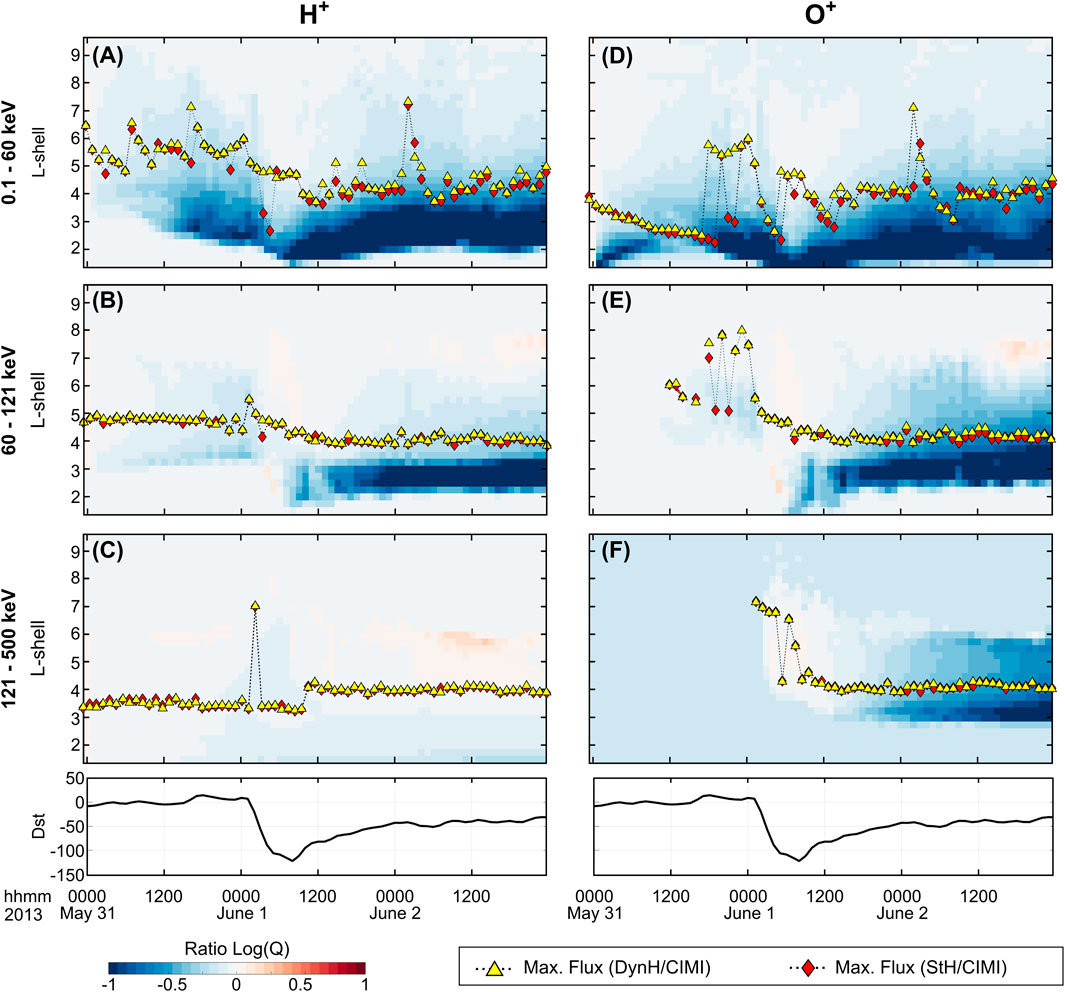
Figure 8. Comparison of MLT-integrated ion fluxes for both species. Panels (A-C) show MLT-integrated Log(Q) ratios corresponding to H+ for low-, mid-, and high-energy ranges, respectively. Panels (D-F) show Log(Q) ratios corresponfing to O+ for low-, mid-, and high-energy ranges. Yellow triangles indicate the L-shell of the ion flux peak in the equatorial solution domain of CIMI when the DynH model is used. Similarly, red diamonds indicate the ion flux peak in the simulation when the StH model is used. These plots serve to identify the L-shell location of ion flux variations during the development of the storm caused by using two distinct exospheric H models.
The higher H density distributions in the DynH model than in StH at ring current altitudes generate significant ion flux depletions during the storm’s development. Panels A and D show that for low-energy
The strong depletion of mid-energy ion fluxes starting after the storm peak (panels B and E) indicates that during the main phase, the injection of these ion energy populations to the ring current system is fast, and charge exchange effects are not strong. Thus, the differences between both runs are not significant. During the recovery phase, however, as activity decreases and ion transport to the inner magnetosphere takes longer, the effects of charge exchange interactions with neutral atoms become important, especially at
Second, we calculated the
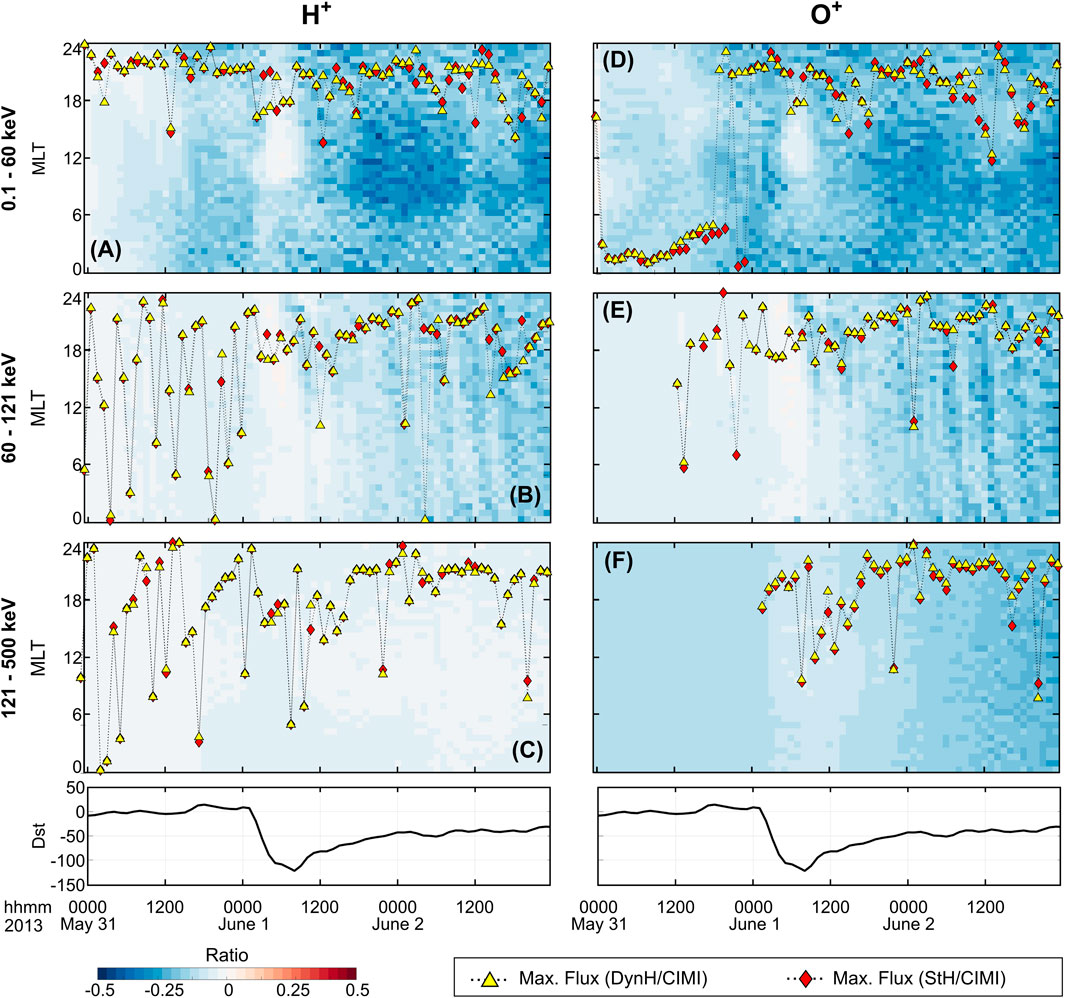
Figure 9. Comparison of L-shell integrated ion fluxes for both species. Panels (A-C) show the Log(Q) ratios corresponding to H+ for low-, mid-, and high-energy ranges, respectively. Panels (D-F) show the Log(Q) ratios corresponding to O+ for low-, mid-, and high-energy ranges, respectively. Yellow triangles and red diamonds follow identical format to Figure 8. These plots serve to identify the MLT (azimuthal) location of ion flux variations during the evolution of the storm yielded by the use of two exospheric H models.
Panels A and D in Figure 9 show that depletion in low-energy ion fluxes due to the use of the DynH model mainly occurs at the dayside region (MLT 6–18 h) during the recovery phase of the storm (1 June 1200 UT to 2 June 1200 UT). Note that ion depletion (both species) during the main phase of the storm (1 June 0000UT to 0900 UT) is almost negligible (Log (
In this section, we calculated the temporal evolution of the total ring current energy (RCE) in units of [

Figure 10. The left panel shows the measured Dst (dotted blue line) and Dst* (dashed blue line) indices and total simulated ring current energy for two runs conducted with the CIMI model. The right panel shows the ratio of total ring current energy using DynH and StH exospheric models.
Figure 11 compares simulated ring current proton fluxes (using DynH and StH) with in situ proton flux measurements acquired by the Helium, Oxygen, Proton, and Electron (HOPE) and the Radiation Belt Storm Probes Ion Composition Experiment (RBSPICE) mass spectrometers onboard NASA’s Van Allen Probes mission. Panels from top to bottom show (a) the proton (energy vs. time) flux spectrogram acquired by the HOPE + RBSPICE instruments during the period under study (May 31 to June 2) and covering ion energies from
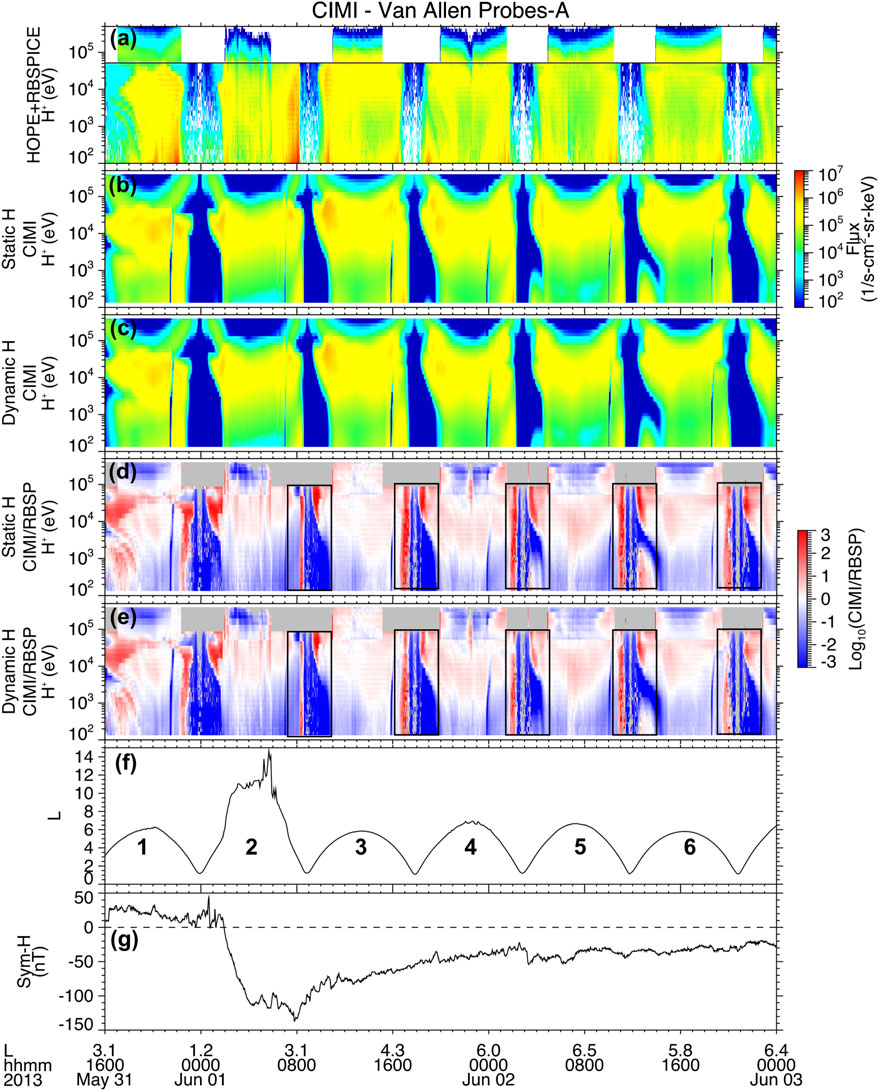
Figure 11. Comparison of proton energy spectrum simulated by CIMI with in situ measurements from HOPE + RBSPICE spectrographs onboard NASA’s Van Allen Probe mission. (a) shows the energy spectrum of in situ measurements provided by HOPE + RBSPICE (H + R) instruments, (b) shows the simulated spectrum from CIMI using the StH model, (c) shows the simulated spectrum from CIMI using the DynH model, (d) shows the ratio
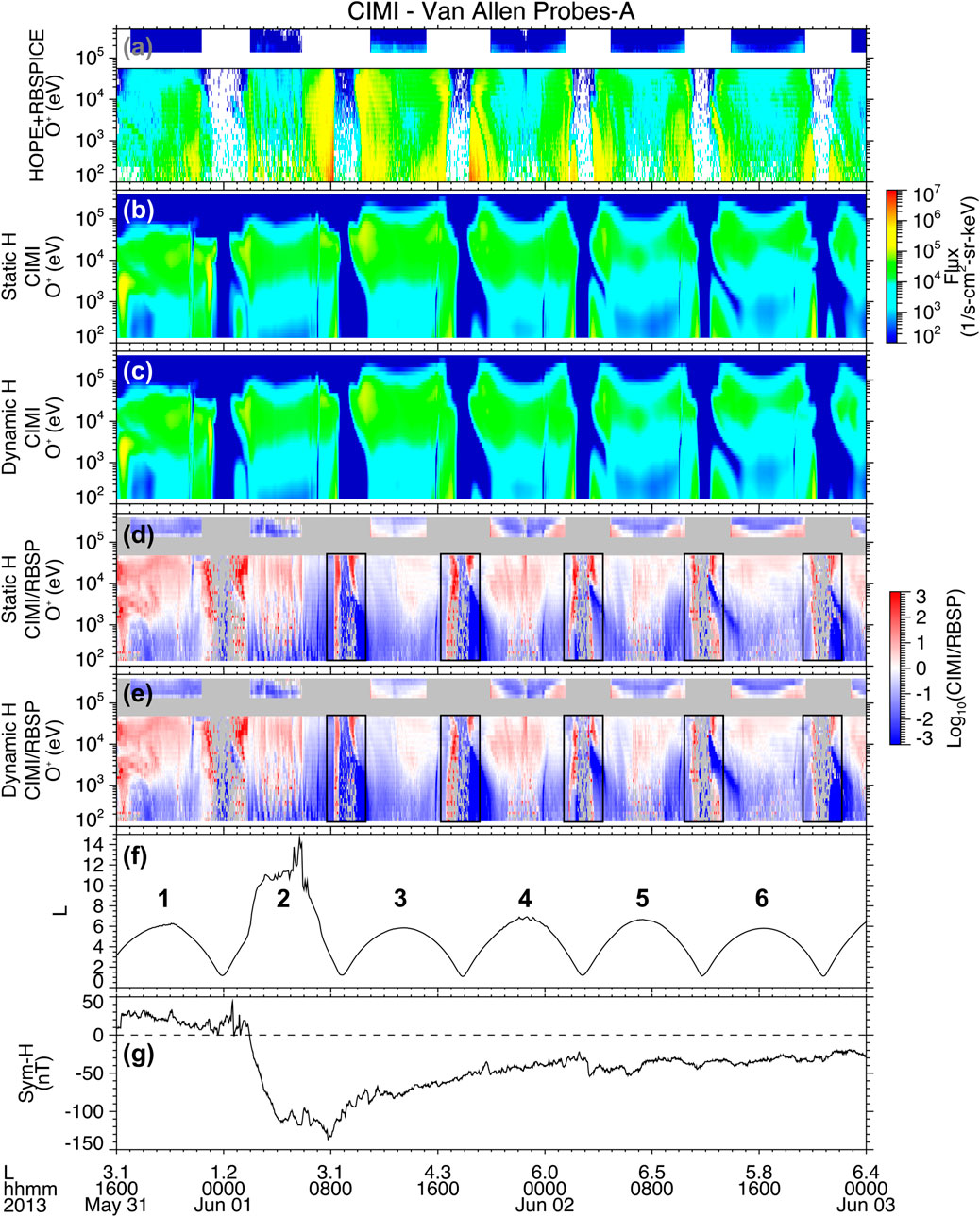
Figure 12. Comparison of O+ energy spectrum simulated by CIMI with in situ measurements from HOPE + RBSPICE spectrographs onboard NASA's Van Allen Probe mission. (a) shows the energy spectrum of in situ measurements provided by HOPE + RBSPICE (H + R) instruments, (b) shows the simulated spectrum from CIMI using the StH model, (c) shows the simulated spectrum from CIMI using the DynH model, (d) shows the ratio Log10[Flux (CIMI +StH)/Flux (H + R)], (e) shows Log10[Flux (CIMI + DynH)/Flux (H + R)], panel (f) shows the L-shell corresponding to the trajectory of Van Allen Probes spacecraft, and panel (g) shows the Sym-H index.
The analysis of CIMI + StH/RBSP (Figure 11d) and CIMI + DynH/RBSP (Figure 11e) ratios indicate that the simulated proton fluxes with both exospheric models have a reasonably good agreement with in situ observations (i.e.,
Figure 13 shows the integrated ion energy flux (for both species) over the energy range of 0.1–500 keV along the path of RBSP-A during the 1 June 2013 storm. For comparison, we also calculated the integrated ion flux for CIMI + StH and CIMI + DynH simulations.
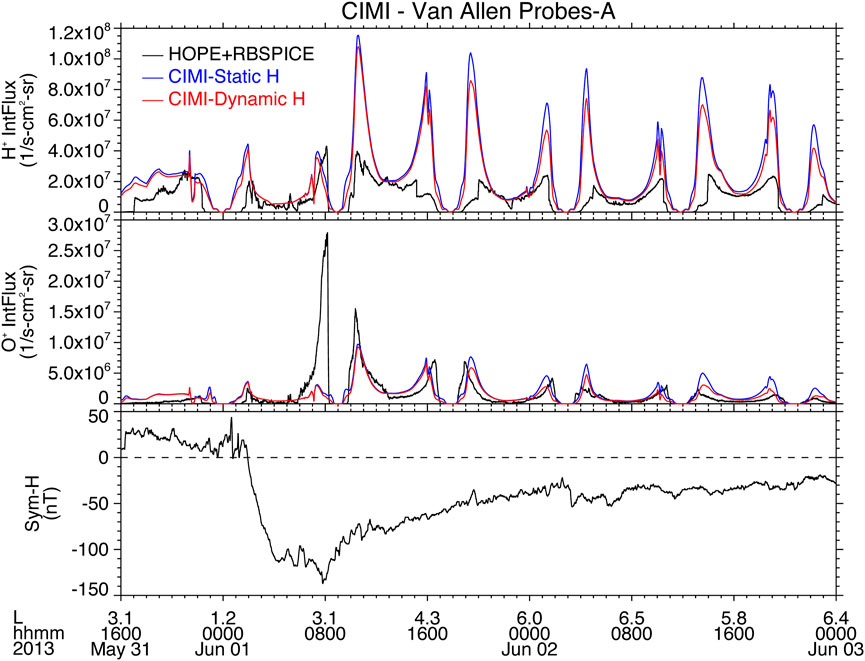
Figure 13. Comparison of integrated ion energy flux along the path of Van Allen Probes mission. The top panel shows the integrated proton energy flux for HOPE + RBSPICE instruments (black line), the CIMI + StH simulation (blue line), and the CIMI + DynH simulation (red line). With a similar format, the central panel shows the integrated
The integrated proton energy flux obtained from CIMI simulations is significantly larger than those measured by RBSP-A at
In this manuscript, we evaluated the role of a realistic exospheric model on the ring current dynamics during the geomagnetic storm that occurred on 1 June 2013. To do so, we used the CIMI model to simulate ring current ion fluxes that respond to two distinct exospheric models. The first is an empirical, temporally static and spherically symmetric model, StH, implemented by Rairden et al. (1986) using H Ly-
In addition, the use of a self-consistent electric field in the CIMI model revealed how the inner magnetospheric electric field is indirectly affected by the exospheric density distributions. Specifically, electric fields are derived through the calculation of ionospheric conductivity and ring current pressure gradients. The latter directly depends on the ion flux, which varies due to the charge exchange with atomic H. Figure 14 shows the evolution of electric fields within the ring current region for simulations using the StH and DynH models. The periods correspond to those used in Figures 4–7. The third column shows the relative difference between electric fields calculated as
1. Global exospheric density distributions derived from FUV observations during the 1 June 2013 storm are significantly asymmetric, with enhanced H densities along the Sun-Earth line (day and night side). Also, the exosphere is dynamic, and the global H densities increase in response to the evolution of the geomagnetic storm, which is associated with an increase in the temperature at the exobase (Chamberlain, 1963) and possible variations in the rate of charge exchange with plasmaspheric ions (Kuwabara et al., 2017).
2. H density values of a realistic exosphere (DynH) at 5.5
3. A general comparison of resulting proton fluxes during the whole storm period using the two exospheric models in CIMI reveals that the run with the DynH model reduces the fluxes up to
4. A similar trend is observed for low-to-mid energy
5. Analysis of
6. Analysis of the azimuthal variations of “
7. The use of the DynH model in the CIMI simulations slightly modifies the ring current flux structure, especially for low-energy ions. This is evidenced by the variations of the peak ion flux locations in Figures 8, 9, panels A and D (yellow triangles for DynH and red diamonds for StH).
8. In the late recovery phase, the total ring current energy using DynH is up to
9. Comparison of simulated ion fluxes with in situ measurements from HOPE/RBSPICE instruments onboard NASA’s Van Allen Probes mission indicates that CIMI systematically overestimates the ion fluxes at low
10. Using a self-consistent electric field in the simulations revealed that atomic H also had, to a lesser extent, an effect on the structure of the ring current. For example, in Figure 4, the ion flux maps for low energy ions on 31 May 10,000 UT, exhibit a narrow flux enhancement in the DynH run with respect to the StH (shown in red). This feature indicates that when the DynH model was used in CIMI, the inner boundary of the ring current slightly moved inward in the dusk region likely associated with an enhanced electric field along the ion drift trajectories. This analysis is with respect to the ring current structure derived from the StH model.
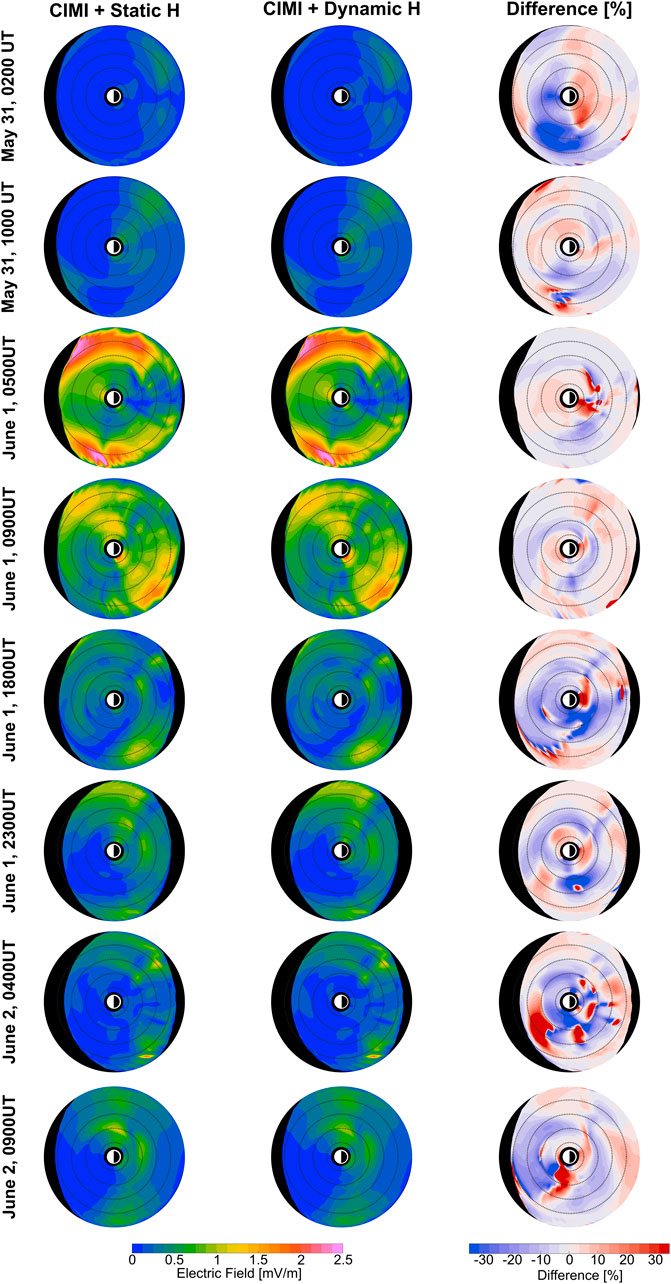
Figure 14. Temporal evolution of the electric field in the ring current for the two simulations. The right column shows the electric field difference between the two runs expressed in percentage values. Concentric black dashed circles indicate geocentric distances of 2, 4, 6 and 8
In summary, our study demonstrates that using a more realistic exospheric H density model reduces ring current ion flux via charge exchange interaction compared to historical H models. Also, an increase of ion fluxes is possible and mainly occurs near the edges of the ring current due to variability of the electric field, which in turn is linked to the neutral hydrogen population. Furthermore, our comparison study indicates that the depletion of ion fluxes is highly correlated to the three-dimensional structure of the exosphere, which clearly depends on the solar cycle and geomagnetic activity. It is noteworthy that each geomagnetic storm may have a particular effect on the exosphere as variations of exobase parameters will depend on the particle injection on the poles, the location of the poles (season), and solar FUV emission.
We acknowledge that our study does not include any interaction of the exosphere and ring current with the terrestrial plasmasphere, which is highly dynamic during storm time. Through charge exchange, plasmaspheric ions can heat atomic H, allowing neutral particles to suddenly populate higher altitudes or even enforce escape (Kuwabara et al., 2017; Bishop and Chamberlain, 1987). Such an effect is not considered in the extrapolation of H densities from the exobase to the optically thin region. On the other hand, the production of plasmaspheric ions (e.g., protons), in turn, depends on low-altitude exospheric and thermospheric H atoms that charge exchange with topside ionospheric
Finally, this study aims to communicate to the magnetospheric community the importance of the terrestrial exosphere in magnetospheric simulations and the opportunity to use actual data from NASA’s Carruthers Geocoronal Observatory (to be launched in 2025), which will image the exosphere in Ly-
NASA's TWINS LAD radiance data is publicly available at the Space Physics Data Facility (https://spdf.gsfc.nasa.gov/). Solar Lyman-Alpha irradiance needed for tomographic reconstructions of exospheric densities is publicly available at LISIRD/LASP repository (https://lasp.colorado.edu/lisird/). The HOPE particle data are available from the Van Allen Probes ECT website at https://rbsp-ect.newmexicoconsortium.org/science/DataDirectories.php. Thermospheric temperature and density were obtained from the WACCM-X model through the Comunity Coordinated Modeling Center (CCMC) and the run (Gonzalo_CuchoPadin_091123_IT_1) is publicly available at https://ccmc.gsfc.nasa.gov.
GC-P: Conceptualization, Formal Analysis, Investigation, Methodology, Writing–original draft, Writing–review and editing. CF: Conceptualization, Formal Analysis, Funding acquisition, Investigation, Methodology, Project administration, Writing–review and editing. M-CF: Conceptualization, Formal Analysis, Methodology, Writing–review and editing. LW: Writing–review and editing. JZ: Data curation, Writing–review and editing. S-BK: Formal Analysis, Methodology, Writing–review and editing.
The author(s) declare that financial support was received for the research, authorship, and/or publication of this article. The author(s) declare that financial support was received for the research, authorship, and/or publication of this article. This research was supported by the NSF-GEM award 2225363 and the NASA Goddard Space Flight Center through Cooperative Agreement 80NSSC21M0180 to Catholic University, Partnership for Heliophysics and Space Environment Research (PHaSER).
The authors thank the TWINS team (PI Dave McComas) for making this work possible. The authors also acknowledge the International Space Science Institute on the ISSI team titled “The Earth’s Exosphere and its Response to Space Weather.”
The authors declare that the research was conducted in the absence of any commercial or financial relationships that could be construed as a potential conflict of interest.
The author(s) declare that no Generative AI was used in the creation of this manuscript.
All claims expressed in this article are solely those of the authors and do not necessarily represent those of their affiliated organizations, or those of the publisher, the editors and the reviewers. Any product that may be evaluated in this article, or claim that may be made by its manufacturer, is not guaranteed or endorsed by the publisher.
Bailey, J., and Gruntman, M. (2011). Experimental study of exospheric hydrogen atom distributions by Lyman-alpha detectors on the TWINS mission. J. Geophys. Res. Space Phys. 116, 1–9. doi:10.1029/.2011JA016531
Baliukin, I. I., Bertaux, J.-L., Quémerais, E., Izmodenov, V. V., and Schmidt, W. (2019). SWAN/SOHO Lyman-alpha mapping: the hydrogen geocorona extends well beyond the Moon. J. Geophys. Res. Space Phys. 124, 861–885. doi:10.1029/2018JA026136
Beth, A., Garnier, P., Toublanc, D., Dandouras, I., and Mazelle, C. (2016). Theory for planetary exospheres: I. Radiation pressure effect on dynamical trajectories. Icarus 266, 410–422. doi:10.1016/j.icarus.2015.10.018
Beth, A., Garnier, P., Toublanc, D., Dandouras, I., Mazelle, C., and Kotova, A. (2014). Modeling the satellite particle population in the planetary exospheres: application to Earth, Titan and Mars. Icarus 227, 21–36. doi:10.1016/j.icarus.2013.07.031
Bishop, J., and Chamberlain, J. W. (1987). Geocoronal structure: 2. inclusion of a magnetic dipolar plasmasphere. J. Geophys. Res. Space Phys. 92, 12377–12388. doi:10.1029/JA092iA11p12377
Brandt, J. C., and Chamberlain, J. W. (1959). Interplanetary gas. I. Hydrogen radiation in the night sky. Astrophys. J. 130, 670–682. doi:10.1086/146756
Chamberlain, J. W. (1963). Planetary coronae and atmospheric evaporation. Planet. Space Sci. 11, 901–960. doi:10.1016/0032-0633(63)90122-3
Cucho-Padin, G., Connor, H., Jung, J., Shoemaker, M., Murphy, K., Sibeck, D., et al. (2024). A feasibility study of 4-d tomography of soft x-ray magnetosheath emissivities using multi-spacecraft measurements. Front. Astronomy Space Sci. 11. doi:10.3389/fspas.2024.1379321
Cucho-Padin, G., Kameda, S., and Sibeck, D. G. (2022). The earth’s outer exospheric density distributions derived from procyon/laica uv observations. J. Geophys. Res. Space Phys. 127, e2021JA030211. doi:10.1029/2021JA03021110.1029/2021ja030211E2021JA030211.2021JA030211
Cucho-Padin, G., and Waldrop, L. (2018). Tomographic estimation of exospheric hydrogen density distributions. J. Geophys. Res. Space Phys. 123, 5119–5139. doi:10.1029/2018ja025323
Cucho-Padin, G., and Waldrop, L. (2019). Time-dependent response of the terrestrial exosphere to a geomagnetic storm. Geophys. Res. Lett. 46, 11661–11670. doi:10.1029/2019gl084327
Dessler, A. J., and Parker, E. N. (1959). Hydromagnetic theory of geomagnetic storms. J. Geophys. Res. (1896-1977) 64, 2239–2252. doi:10.1029/JZ064i012p02239
Emmert, J. T., Drob, D. P., Picone, J. M., Siskind, D. E., Jones, Jr. M., Mlynczak, M. G., et al. (2021). NRLMSIS 2.0: a whole-atmosphere empirical model of temperature and neutral species densities. Earth Space Sci. 8, e2020EA001321. doi:10.1029/2020ea001321
Ferradas, C., Reeves, G., Larsen, B., Skoug, R., Zhang, J.-C., Funsten, H., et al. (2021). The effects of the location and the timing of local convection electric field enhancements in the formation of ion multiple-nose structures. J. Atmos. Solar-Terrestrial Phys. 216, 105534. doi:10.1016/j.jastp.2020.105534
Ferradas, C. P., Zhang, J.-C., Kistler, L. M., and Spence, H. E. (2015). Heavy-ion dominance near cluster perigees. J. Geophys. Res. Space Phys. 120, 10,485–510. doi:10.1002/2015JA021063
Ferradas, C. P., Zhang, J.-C., Spence, H. E., Kistler, L. M., Larsen, B. A., Reeves, G., et al. (2016). Ion nose spectral structures observed by the van allen probes. J. Geophys. Res. Space Phys. 121 (12). doi:10.1002/2016JA022942
Fok, M.-C., Buzulukova, N. Y., Chen, S.-H., Glocer, A., Nagai, T., Valek, P., et al. (2014). The comprehensive inner magnetosphere-ionosphere model. J. Geophys. Res. Space Phys. 119, 7522–7540. doi:10.1002/2014ja020239
Fok, M.-C., Kang, S.-B., Ferradas, C. P., Buzulukova, N. Y., Glocer, A., and Komar, C. M. (2021). New developments in the comprehensive inner magnetosphere-ionosphere model. J. Geophys. Res. Space Phys. 126, e2020JA028987. doi:10.1029/2020ja028987
Fok, M. C., Kozyra, J. U., Nagy, A. F., Rasmussen, C. E., and Khazanov, G. V. (1993). Decay of equatorial ring current ions and associated aeronomical consequences. J. Geophys. Res. Space Phys. 98, 19381–19393. doi:10.1029/93JA01848
Fok, M.-C., Wolf, R. A., Spiro, R. W., and Moore, T. E. (2001). Comprehensive computational model of earth’s ring current. J. Geophys. Res. Space Phys. 106, 8417–8424. doi:10.1029/2000JA000235
Hodges, R. R. (1994). Monte Carlo simulation of the terrestrial hydrogen exosphere. J. Geophys. Res. Space Phys. 99, 23229–23247. doi:10.1029/.94JA02183
Ilie, R., Liemohn, M. W., Toth, G., and Skoug, R. M. (2012). Kinetic model of the inner magnetosphere with arbitrary magnetic field. J. Geophys. Res. Space Phys. 117. doi:10.1029/2011ja017189
Ilie, R., Skoug, R., Funsten, H. O., Liemohn, M. W., Bailey, J. J., and Gruntman, M. (2013). The impact of geocoronal density on ring current development. J. Atmos. Solar-Terrestrial Phys. 99, 92–103. doi:10.1016/j.jastp.2012.03.010
Jordanova, V. K. (2020). “Chapter 6 - ring current decay,” in Ring current investigations. Editors V. K. Jordanova, R. Ilie, and M. W. Chen (Elsevier), 181–223. doi:10.1016/B978-0-12-815571-4.00006-8
Kistler, L. M., Ipavich, F. M., Hamilton, D. C., Gloeckler, G., Wilken, B., Kremser, G., et al. (1989). Energy spectra of the major ion species in the ring current during geomagnetic storms. J. Geophys. Res. Space Phys. 94, 3579–3599. doi:10.1029/JA094iA04p03579
Kistler, L. M., Möbius, E., Klumpar, D. M., Popecki, M. A., Tang, L., Jordanova, V., et al. (1998). Fast/teams observations of charge exchange signatures in ions mirroring at low altitudes. Geophys. Res. Lett. 25, 2085–2088. doi:10.1029/98GL00331
Kotov, D., Richards, P. G., Reznychenko, M., Bogomaz, O., Truhlík, V., Nossal, S., et al. (2023). Interhemispheric ionosphere-plasmasphere system shows a high sensitivity to the exospheric neutral hydrogen density: a caution of the global reference atmospheric model hydrogen density. Front. Astronomy Space Sci. 10. doi:10.3389/.fspas.2023.1113706
Krall, J., Glocer, A., Fok, M.-C., Nossal, S. M., and Huba, J. D. (2018). The unknown hydrogen exosphere: space weather implications. Space weather. 16, 205–215. doi:10.1002/2017SW001780
Kuwabara, M., Yoshioka, K., Murakami, G., Tsuchiya, F., Kimura, T., Yamazaki, A., et al. (2017). The geocoronal responses to the geomagnetic disturbances. J. Geophys. Res. Space Phys. 122, 1269–1276. doi:10.1002/2016ja023247
Liu, J., Ilie, R., Borovsky, J. E., and Liemohn, M. W. (2022). A new mechanism for early-time plasmaspheric refilling: the role of charge exchange reactions in the transport of energy and mass throughout the ring current—plasmasphere system. J. Geophys. Res. Space Phys. 127, e2022JA030619. doi:10.1029/2022ja030619
Lundin, R., Lyons, L. R., and Pissarenko, N. (1980). Observations of the ring current composition at l 4. Geophys. Res. Lett. 7, 425–428. doi:10.1029/GL007i006p00425
McComas, D. J., Allegrini, F., Baldonado, J., Blake, B., Brandt, P. C., Burch, J., et al. (2009). The two wide-angle imaging neutral-atom spectrometers (TWINS) NASA mission-of-opportunity. Space Sci. Rev. 142, 157–231. doi:10.1007/s11214-008-9467-4
McIlwain, C. E. (1972). “Plasma convection in the vicinity of the geosynchronous orbit,” in Earth’s magnetospheric processes. Editor B. M. McCormac (Dordrecht: Springer Netherlands), 268–279.
Moldwin, M. B., Downward, L., Rassoul, H. K., Amin, R., and Anderson, R. R. (2002). A new model of the location of the plasmapause: crres results. J. Geophys. Res. Space Phys. 107 (SMP 2–1), 2–9. doi:10.1029/2001JA009211
Morley, S. K., Brito, T. V., and Welling, D. T. (2018). Measures of model performance based on the log accuracy ratio. Space weather. 16, 69–88. doi:10.1002/.2017SW001669
Nossal, S. M., Mierkiewicz, E. J., and Roesler, F. L. (2012). Observed and modeled solar cycle variation in geocoronal hydrogen using NRLMSISE-00 thermosphere conditions and the bishop analytic exosphere model. J. Geophys. Res. Space Phys. 117. doi:10.1029/2011ja017074
Pandya, M., Veenadhari, B., Nosé, M., Kumar, S., Reeves, G. D., and Lui, A. T. Y. (2018). Characteristics of storm time ion composition in the near-earth plasma sheet using geotail and rbsp measurements. Earth, Planets Space 70, 203. doi:10.1186/s40623-018-0977-3
Qin, J., Waldrop, L., and Makela, J. J. (2017). Redistribution of H atoms in the upper atmosphere during geomagnetic storms. J. Geophys. Res. Space Phys. 122, 10,686–710. doi:10.1002/2017ja024489
Rairden, R. L., Frank, L. A., and Craven, J. D. (1986). Geocoronal imaging with dynamics explorer. J. Geophys. Res. Space Phys. 91, 13613–13630. doi:10.1029/ja091ia12p13613
Tsyganenko, N. A., Singer, H. J., and Kasper, J. C. (2003). Storm-time distortion of the inner magnetosphere: how severe can it get? J. Geophys. Res. Space Phys. 108. doi:10.1029/2002ja009808
Tsyganenko, N. A., and Sitnov, M. I. (2005). Modeling the dynamics of the inner magnetosphere during strong geomagnetic storms. J. Geophys. Res. Space Phys. 110. doi:10.1029/2004JA010798
Waldrop, L., and Paxton, L. J. (2013). Lyman-alpha airglow emission: implications for atomic hydrogen geocorona variability with solar cycle. J. Geophys. Res. Space Phys. 118, 5874–5890. doi:10.1002/jgra.50496
Weimer, D. R. (2001). An improved model of ionospheric electric potentials including substorm perturbations and application to the geospace environment modeling november 24, 1996, event. J. Geophys. Res. Space Phys. 106, 407–416. doi:10.1029/2000ja000604
Young, D. T., Balsiger, H., and Geiss, J. (1982). Correlations of magnetospheric ion composition with geomagnetic and solar activity. J. Geophys. Res. Space Phys. 87, 9077–9096. doi:10.1029/ja087ia11p09077
Zesta, E., and Oliveira, D. M. (2019). Thermospheric heating and cooling times during geomagnetic storms, including extreme events. Geophys. Res. Lett. 46, 12739–12746. doi:10.1029/2019GL085120
Zoennchen, J., Cucho-Padin, G., Waldrop, L., and Fahr, H. (2024). Comparison of terrestrial exospheric hydrogen 3d distributions at solar minimum and maximum using twins lyman-alpha observations. Front. Astronomy Space Sci. 11. doi:10.3389/fspas.2024.1409744
Zoennchen, J. H., Nass, U., and Fahr, H. J. (2013). Exospheric hydrogen density distributions for equinox and summer solstice observed with TWINS1/2 during solar minimum. Ann. Geophys. 31, 513–527. doi:10.5194/angeo-31-513-2013
Zoennchen, J. H., Nass, U., and Fahr, H. J. (2015). Terrestrial exospheric hydrogen density distributions under solar minimum and solar maximum conditions observed by the TWINS stereo mission. Ann. Geophys. 33, 413–426. doi:10.5194/angeo-33-413-2015
Keywords: exosphere, ring current, tomography, magnetosphere, ion-neutral coupling
Citation: Cucho-Padin G, Ferradas CP, Fok M-C, Waldrop L, Zoennchen J and Kang S-B (2025) The role of the dynamic terrestrial exosphere in the storm-time ring current decay . Front. Astron. Space Sci. 12:1533126. doi: 10.3389/fspas.2025.1533126
Received: 23 November 2024; Accepted: 03 March 2025;
Published: 26 March 2025.
Edited by:
Julio Navarro, University of Victoria, CanadaReviewed by:
Joseph E. Borovsky, Space Science Institute (SSI), United StatesCopyright © 2025 Cucho-Padin, Ferradas, Fok, Waldrop, Zoennchen and Kang. This is an open-access article distributed under the terms of the Creative Commons Attribution License (CC BY). The use, distribution or reproduction in other forums is permitted, provided the original author(s) and the copyright owner(s) are credited and that the original publication in this journal is cited, in accordance with accepted academic practice. No use, distribution or reproduction is permitted which does not comply with these terms.
*Correspondence: Gonzalo Cucho-Padin, Z29uemFsb2F1Z3VzdG8uY3VjaG9wYWRpbkBuYXNhLmdvdg==
Disclaimer: All claims expressed in this article are solely those of the authors and do not necessarily represent those of their affiliated organizations, or those of the publisher, the editors and the reviewers. Any product that may be evaluated in this article or claim that may be made by its manufacturer is not guaranteed or endorsed by the publisher.
Research integrity at Frontiers

Learn more about the work of our research integrity team to safeguard the quality of each article we publish.